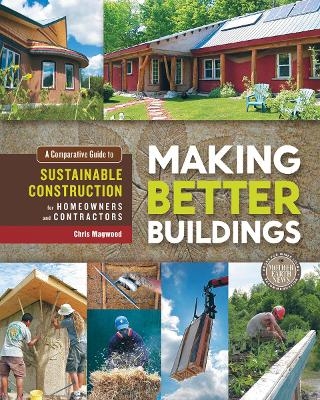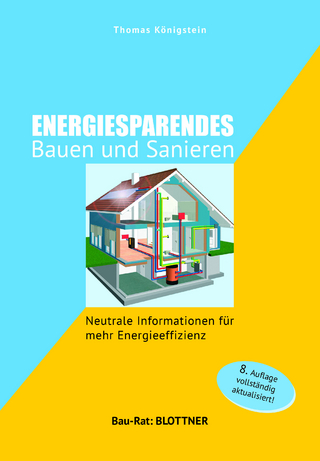
Making Better Buildings
New Society Publishers (Verlag)
978-0-86571-706-0 (ISBN)
- Titel z.Zt. nicht lieferbar
- Versandkostenfrei
- Auch auf Rechnung
- Artikel merken
From foundation to finish, a wealth of information is available on sustainable construction methods--entire volumes have been published on individual green and natural building techniques. But with so many different ideas to choose from, there is no single resource that allows an owner or builder to quickly and objectively compare the merits of each system for their particular project. Making Better Buildings cuts through the hype and provides the unvarnished facts about the upsides and downsides of the most widely discussed materials and technologies. Drawing on the real-world experiences of designer/builders, this comparative guide systematically and comprehensively examines each approach in terms of:* Cost, sourcing, availability, labor intensity, and ease of construction* Energy efficiency, embodied energy, and environmental impacts* Availability/accessibility Each chapter is rounded out by a chart which summarizes the material in a quick and accessible manner.
Whether you are an owner preparing to build a green or natural home or a conventional contractor determined to integrate sustainable alternatives into your existing construction practices, this up-to-the minute resource will help you make the best decisions for your project while meeting your energy, efficiency, budgetary, and site-specific needs. Chris Magwood and Jen Feigin are sustainable builders and designers specializing in green and natural building techniques, and are the founders and directors of the Endeavour Centre for Innovative Building and Living. Chris is also the author of three previous books on sustainable building, including Straw Bale Details and More Straw Bale Building.
Jen Feigin is a designer, carpenter and natural builder specializing in sustainable design with a strong focus on straw bale wall systems and many other natural building techniques. Together with Chris Magwood, Jen is a founder and director of the Endeavour Centre for Innovative Building and Living based in Peterborough, Ont. She owns and operates Green Hammer Construction, and has been an instructor and project manager with the Sustainable Building Design and Construction program at Fleming College since 2007. Jen teaches workshops on natural building techniques across Ontario. Chris Magwood has designed and built some of the most innovative, sustainable buildings in North America, including the first off-grid, straw bale home in Ontario which became a fifteen-year research project into the implementation of sustainable building materials and technologies. He created the Sustainable Building Design and Construction program at Fleming College in 2005, and together with Jen Feigin founded and directs the Endeavour Centre for Innovative Building and Living. Chris is the author of 3 previous books on sustainable building including Straw Bale Details and More Straw Bale Building.
Thanks Author's note Foreword by David Eisenberg Introduction: Thinking about sustainable building How this book works 1 Foundations Building science for foundations Earthbag (or flexible form rammed earth) foundations Dry stone and mortared stone foundations Rammed earth tires (earthships) Helical pier, screwpile and screw pier foundations Wooden piers Poured concrete foundations Lightweight concrete masonry units (CMUs) Autoclaved aerated concrete blocks Durisol and Faswall insulated concrete forms (ICFs) What about rubble trenches? Combination foundations What's not included in this chapter Pressure treated wood foundations Concrete slab foundations 2 Walls Building science basics for walls Wood frame construction Straw bale walls Cob walls Cordwood or stackwall Rammed earth walls Compressed earth block (CEB) walls Adobe block walls Foundations as walls Cotton batt insulation Straw/clay, straw light clay or slipstraw insulation Hempcrete insulation Hemp batt insulation Perlite loose-fill insulation Mineral wool insulation Cementitious foam insulation Wool batt insulation Cellulose insulation (wet-sprayed and dry-blown) Other insulation materials What's not included in this chapter 3 Floor and roof structure Building science basics for floor structures Building science basics for roof structures Wood framing Wooden trusses Wooden I-beams Finger-jointed wood trusses Glulam roof and floor framing Open web steel joists Timber framing and post and beam Conical grain bin roofs Slab-based floors 4 Sheathing and cladding materials Building science basics for exterior cladding and sheathing Building science basics for interior sheathing Clay or earthen plaster Wood plank sheathing and cladding Plywood and oriented strand board (OSB) sheathing Gypsum board, drywall or plaster board sheathing Magnesium oxide board Fired clay brick cladding Lime and lime/cement plaster Stone cladding Roof sheathing materials as wall sheathing 5 Roof sheathing Building science basics for roof sheathing Metal roofing Cedar shake and shingles Thatch roofs Slate Composite shingles Green roofs/living roofs Clay tile roofing 6 Flooring Building science basics for flooring Clay or earthen floors Hardwood flooring Softwood flooring Engineered wood floors Tile flooring Linoleum Bamboo flooring Cork flooring Concrete flooring 7 Surface finishing materials Building science basics for finishes Clay or earthen finish plaster Lime finish plaster Milk paint Clay paint and alise Lime wash and lime paint Silicate paint Acrylic (latex) paint Natural oil paint Natural oils and waxes Natural wallpaper and wall covering 8 Windows 9 Water systems Water sources Surface water Well water Rainwater catchment Desalinated water Pumps Filters Water treatment systems Piping 11 Wastewater systems Municipal wastewater treatment Septic systems Composting toilets 12 Heating and cooling systems Means of heat production Means of heat delivery Passive solar heating Solar hydronic heating Solar hot air heating Ground source heat pumps (GSHP) Air source heat pumps (ASHP) Tankless or on-demand heaters Tank or batch heaters Forced-air furnaces Wood and pellet stoves Masonry heaters 13 Electrical generation Photovoltaic power Wind turbines Micro-hydro turbines Conclusion People make better buildings Appendix Inventory of carbon and energy (ICE) summary Index About the author
| Erscheint lt. Verlag | 1.3.2014 |
|---|---|
| Verlagsort | Gabriola Island |
| Sprache | englisch |
| Maße | 203 x 232 mm |
| Gewicht | 912 g |
| Themenwelt | Sachbuch/Ratgeber ► Freizeit / Hobby ► Hausbau / Einrichten / Renovieren |
| Sachbuch/Ratgeber ► Gesundheit / Leben / Psychologie | |
| Naturwissenschaften ► Biologie ► Ökologie / Naturschutz | |
| Technik ► Architektur | |
| ISBN-10 | 0-86571-706-0 / 0865717060 |
| ISBN-13 | 978-0-86571-706-0 / 9780865717060 |
| Zustand | Neuware |
| Haben Sie eine Frage zum Produkt? |
aus dem Bereich


